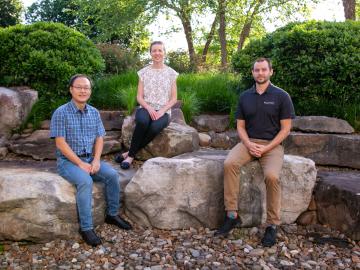Filter News
Area of Research
- (-) Supercomputing (26)
- Biology and Environment (36)
- Biology and Soft Matter (1)
- Clean Energy (20)
- Computer Science (1)
- Electricity and Smart Grid (1)
- Functional Materials for Energy (2)
- Fusion and Fission (11)
- Isotopes (1)
- Materials (19)
- Materials for Computing (3)
- National Security (21)
- Neutron Science (4)
News Type
News Topics
- Artificial Intelligence (5)
- Big Data (2)
- Bioenergy (2)
- Biology (3)
- Biomedical (2)
- Buildings (2)
- Climate Change (3)
- Computer Science (6)
- Coronavirus (2)
- Decarbonization (2)
- Energy Storage (1)
- Environment (3)
- Exascale Computing (2)
- Frontier (4)
- Grid (1)
- High-Performance Computing (6)
- Machine Learning (3)
- Materials (6)
- Materials Science (5)
- Microscopy (1)
- Nanotechnology (2)
- National Security (1)
- Neutron Science (1)
- Quantum Computing (5)
- Quantum Science (3)
- Security (1)
- Simulation (4)
- Space Exploration (1)
- Summit (5)
- Sustainable Energy (2)
Media Contacts

ORNL’s next major computing achievement could open a new universe of scientific possibilities accelerated by the primal forces at the heart of matter and energy.

Vivien Zapf has been named deputy director of the Quantum Science Center headquartered at ORNL. The QSC combines resources and expertise from national laboratories, universities and industry partners to accelerate the design and development of novel quantum technologies.

ORNL researchers are deploying their broad expertise in climate data and modeling to create science-based mitigation strategies for cities stressed by climate change as part of two U.S. Department of Energy Urban Integrated Field Laboratory projects.

Gang Seob “GS” Jung has known from the time he was in middle school that he was interested in science.

A new paper published in Nature Communications adds further evidence to the bradykinin storm theory of COVID-19’s viral pathogenesis — a theory that was posited two years ago by a team of researchers at the Department of Energy’s Oak Ridge National Laboratory.

Five National Quantum Information Science Research Centers are leveraging the behavior of nature at the smallest scales to develop technologies for science’s most complex problems.

Researchers at the Department of Energy’s Oak Ridge National Laboratory and their technologies have received seven 2022 R&D 100 Awards, plus special recognition for a battery-related green technology product.

Travis Humble has been named director of the Quantum Science Center headquartered at ORNL. The QSC is a multi-institutional partnership that spans industry, academia and government institutions and is tasked with uncovering the full potential of quantum materials, sensors and algorithms.

The Department of Energy’s Office of Science has selected three Oak Ridge National Laboratory scientists for Early Career Research Program awards.

To optimize biomaterials for reliable, cost-effective paper production, building construction, and biofuel development, researchers often study the structure of plant cells using techniques such as freezing plant samples or placing them in a vacuum.




